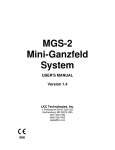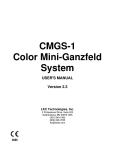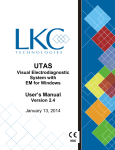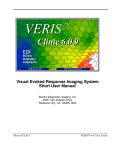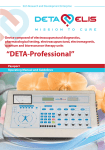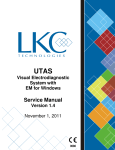Download CMGS-1 & MGS-2 Service Manual
Transcript
CMGS-1 Color Mini-Ganzfeld System SERVICE MANUAL Version 2.1 . LKC Technologies, Inc. 2 Professional Drive, Suite 222 Gaithersburg, MD 20879 USA (301) 840-1992 (800) 638-7055 General: [email protected] Service: [email protected] 0086 WARRANTY LKC Technologies, Inc. unconditionally warrants this instrument to be free from defects in materials and workmanship, provided there is no evidence of abuse or attempted repairs without authorization from LKC Technologies, Inc. This Warranty is binding for one year from date of initial delivery and is limited to: servicing and/or replacing any instrument, or part thereof, returned to the factory for that purpose with transportation charges prepaid and which are found to be defective. This Warranty is made expressly in lieu of all other liabilities and obligations on the part of LKC Technologies, Inc. DAMAGE UPON ARRIVAL. Each instrument leaves our plant, after rigorous tests, in perfect operating condition. The instrument may receive rough handling and damage in transit. The shipment is insured against such damage. The Buyer must report, in writing, immediately any concealed or apparent damage to the last carrier. Report any damage also to us, and issue an order for replacement or repair. DEFECTS OCCURRING WITHIN WARRANTY PERIOD. Parts of units may develop defects which no amount of initial testing will reveal. The price of our instruments makes provision for such service, but it does not: 1. 2. 3. Provide for transportation charges to our factory for service, Provide for services not performed or authorized by us, Provide for the cost of repairing instruments that have obviously been abused or subjected to unusual environments for which they have not been designed. We will be happy at any time to discuss by phone, letter, FAX, or e-mail suspected defects or aspects of instrument operation that may be unclear. We advise you to inform us by phone, letter FAX, or e-mail of the nature of the defect before returning an instrument for repair. Many times a simple suggestion will solve the problem without returning an instrument to the factory. If we are unable to suggest something that solves the problem, we will advise you as to what parts of the equipment should be returned to the factory for service. DEFECTS OCCURRING AFTER WARRANTY PERIOD. Charges for repairs after the warranty period will be based upon actual hours spent on the repair at the then prevailing rate, plus cost of parts required and transportation charges, or you may elect to purchase an extended warranty. We will be happy to discuss by phone, letter, FAX, or e-mail any problem you may be experiencing. i LKC Technologies, Inc. Customer Support (800) 638-7055 FAX Number (301) 330-2237 e-mail [email protected] ii Notice The CMGS-1 is an FDA Class I medical device. To ensure patient safety, the CMGS-1 is isolated from the power mains by an internal power supply. iii Table of Contents 1. INTRODUCTION..............................................................................................................................................2 1.1. SAFETY ........................................................................................................................................................2 1.2. USE .............................................................................................................................................................2 1.3. .................................................................................................................... ERROR! BOOKMARK NOT DEFINED. 2. FUNCTIONAL DESCRIPTION ......................................................................................................................3 2.1. 2.2. 3. SETTING UP THE SYSTEM ...........................................................................................................................6 3.1. 3.2. 4. CALIBRATION SCHEDULE .............................................................................................................................7 OVERVIEW OF FLASH MEASUREMENTS .........................................................................................................7 MEASURING BACKGROUND LIGHT INTENSITIES ...........................................................................................8 MEASURING FLASH INTENSITIES ..................................................................................................................8 TROUBLESHOOTING GUIDE.......................................................................................................................9 5.1. 5.2. 5.3. 5.4. 6. EQUIPMENT INTERCONNECTIONS .................................................................................................................6 TRIGGER CONNECTIONS. .............................................................................................................................6 CALIBRATION .................................................................................................................................................7 4.1. 4.2. 4.3. 4.4. 5. CMGS-1 MAIN UNIT ...................................................................................................................................3 KÜRBISFELD HANDPIECE .............................................................................................................................5 LCD DISPLAY DOES NOT LIGHT ....................................................................................................................9 HANDPIECE STIMULATOR ............................................................................................................................9 KURBISFELD KEYPAD...................................................................................................................................9 FLASH OR BACKGROUND LIGHTS INCORRECT ...............................................................................................9 CLEANING ......................................................................................................................................................10 6.1. CLEANING THE CMGS-1 ...........................................................................................................................10 1 1. Introduction The LKC CMGS-1 represents the finest equipment commercially available for stimulating the retina and optic nerve for evoked potential testing. The equipment has been designed for simplicity of operation. This manual describes how to interconnect the equipment, calibration, tests, the theory of circuit operation as a guide to troubleshooting to the board replacement level, and troubleshooting guide that lists the most commonly encountered problems. 1.1. Safety The equipment has been tested in accordance with AAMI safe current limit standards and meets all requirements for nonisolated patient connections. WARNING The CMGS-1 is an FDA Class I medical device. To ensure patient safety, the CMGS-1 is isolated from the power mains by an internal power supply. 1.2. Use This equipment is offered for sale only to qualified health professionals. The improper use of this equipment may be injurious to the patient. 2 2. Functional Description In this section the function of each equipment group is explained and a block diagram is discussed which shows equipment interrelationships. As block diagram of the CMGS-1 is shown in Figure 1 on the following page. The Kurbisfeld handpiece is controlled by an embedded microcontroller, located on the CMGS-1 main unit. This board receives commands from the user input pushbuttons. These commands are decoded and signals are sent to the necessary subsystems. Each flash intensity and color uses a combination of LEDs to produce the required stimulus. All flashes have a duration of less than 5 milliseconds, except for long-duration stimuli, which are under user control from 100 to 5000 milliseconds. 2.1. CMGS-1 Main Unit The main unit of the CMGS-1 includes the power supply, the LCD and pushbutton menu system, and all stimulus control electronics. The calibration data for controlling stimulus intensity and color is stored in a microcontroller inside this main unit. The CMGS-1 main unit contains two printed circuit boards. The printed circuit boards and their quantities are: Kurbisfeld Interface board Display board The Display board contains the electronics that control the LCD display and pushbuttons on the front panel, and send command code to the Interface board. The Interface board decodes these commands and stimulus parameters of the handpiece. 3 Figure 1 CMGS-1 Overall 4 2.2. Kürbisfeld Handpiece The Kürbisfeld handpiece stimulator provides both the flash and fixation stimuli for visual electrodiagnostic testing. The main unit triggers the flash, and controls the brightness of the background light. This device utilizes an array of high-brightness LEDs to generate all visual stimuli. The Kürbisfeld can provide white flash stimuli over a 3.5 log unit range, from 2.5 log units below the ISCEV “maximal flash” intensity to 1 log units above it. The white flash intensities that the Kürbisfeld provides are: -25 dB, -20 dB, -15 dB, -10 dB, -5 dB, 0 dB, +5 dB and +10 dB. For all color flashes (red, green, and blue), the intensities provided are: -25 dB, -20 dB, -15 dB, -10 dB, -5 dB, 0 dB, and +2 dB (range of 2.7 log units). The Kürbisfeld background light has 5 intensities: 15, 30, 60, 300, and 1000 cd/m2. Color background lights cannot be generated at the 1000 cd/m2 level. Only the first four levels will be available. 5 Service Manual 3. 3.1. Setting Up the System Setting Up the System Equipment Interconnections This section details the connections among the various pieces of equipment. CMGS-1 main unit to handpiece. These two devices connect at the back of the main unit, using 25-pin connectors. Power Connections. The CMGS-1 main unit should be plugged into an AC wall outlet. This device uses a universal switching power supply, which accepts line 85 – 264 volts, 47 – 63 Hz AC input. 3.2. Trigger Connections. Please consult the CMGS-1 User’s Manual for specific information regarding trigger input and output connections. 6 Service Manual 4. Calibration Calibration 4.1. Calibration Schedule Flash intensity, flash color, and background color must be calibrated at the factory. LKC recommends that users return their CMGS-1 for calibration every two years. 4.2. Overview of flash measurements Although the CMGS-1 cannot be calibrated in the field, it is possible to test the flash intensities and background light levels if you have the proper equipment. Flash intensities are measured in cd⋅s⋅m-2 using an integrating photometer. Background 3.426 cd m 2 ≡ 1 ft L light intensities are measured in cd⋅m-2 using a standard photometer. LKC uses a Model 2550 Digital Radiometer/Photometer for calibrating systems at the factory. Other photometers are acceptable for testing if they measure light intensity in either candelas per square meter (cd⋅m-2) or in foot-Lamberts (fL). The photometer must also be capable of integrating its response to measure candela-seconds per square meter (cd⋅s⋅m-2 ) or foot-Lambert-seconds (fL-s). Flash intensities are often referred to in decibels (dB). The term dB is a relative one, as shown in the equation: Where I(0) is the intensity at 0 dB and I(x) is the intensity at x dB. The intensity at 0 dB is between dB = 10 log I(x) I(0) 1.5 and 3.0 cd⋅s⋅m-2 for this system. So, for example, a -20 dB stimulus would be approximately 0.02 cd⋅s⋅m-2. 7 Service Manual 4.3. Calibration Measuring Background Light Intensities You can measure them periodically to assure that they have not changed significantly. 4.4. Measuring Flash Intensities If you have an integrating photometer, you should measure the flash intensities periodically to assure that they have not changed significantly. You must set your photometer to its integrating mode to measure the flash units. The flash intensity measurements must be made in a completely darkened room. 8 Service Manual 5. Troubleshooting Guide Troubleshooting Guide This section lists the most frequently encountered problems along with typical solutions. 1. 2. 3. 4. 5.1. LCD display does not light Power is OFF Internal power supply is defective Loose cable between Kurbisfeld Interface board and LCD display board Back light circuit in LCD module is defective 5.2. Handpiece Stimulator No flash stimulators functioning. (No Kürbisfeld function) 1. Cable from main unit to Kürbisfeld not properly connected 2. Loose cable inside main unit 3. Loose cable inside handpiece 4. Bad power supply 5.3. Kurbisfeld keypad Kürbisfeld Keypad does not work, but can be controlled by mouse 1. Loose wire connection from Kürbisfeld to main unit 2. Bad keypad inside the Kürbisfeld 5.4. Flash or background lights incorrect Flash intensities are obviously too low or too high, or flash colors are obviously incorrect 1. The EPROM on the Kurbisfeld Interface board may need to be re-initialized: 1. 2. 3. 4. 5. 6. 7. 8. 9. Turn the power off. Remove the top cover of the CMGS-1 main unit. Locate the set of DIP switches labeled SW9 on the back of the LCD display board. Move switch #4 to the ON position. Turn on the power of the CMGS-1. Wait about 10 seconds. Turn off the power of the CMGS-1. Move switch #4 of the SW9 back to the OFF position. Close the cover of the unit using the Philips screws. 9 Service Manual 6. Cleaning Cleaning 6.1. Cleaning the CMGS-1 The outer plastic surfaces of the CMGS-1 and the associated handpiece may be cleaned with any mild detergent and a damp cloth. Cleaning of the outer surfaces should be performed annually, or after excessive dirt or oil buildup. No parts of the system should be submerged in water of any other material at any time. 10














